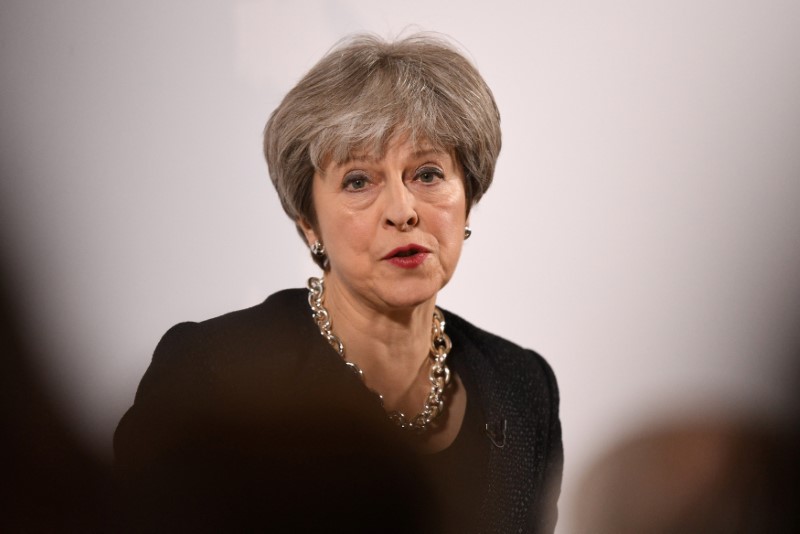 © Reuters. Britain’s Prime Minister Theresa May delivers a speech about her vision for Brexit, at Mansion House in London
© Reuters. Britain’s Prime Minister Theresa May delivers a speech about her vision for Brexit, at Mansion House in LondonBy Elizabeth Piper
LONDON (Reuters) – British Prime Minister Theresa May called for a deep partnership with the European Union after Brexit, setting out ambitions for a tailor-made deal including financial services but accepting EU regulation of chemicals, medicines and aerospace industries.
In an attempt to add detail to Britain’s negotiation on leaving the EU, May mixed concessions with a plea for a deal that would keep trade flowing between the world’s biggest trade bloc and Britain’s $2.7 trillion economy.
May proposed having either a customs partnership, where Britain would implement EU tariffs on its border for goods intended for the EU but could set different ones for goods going elsewhere, or a streamlined customs arrangement, where jointly implemented measures would minimize frictions to trade.
But she also proposed Britain having access to the EU’s financial markets in return for having similar standards to those of the EU, which would in turn keep access to Europe’s biggest and deepest markets in London.
“We all need to face up to some hard facts,” May told ambassadors and business leaders in the Mansion House, the 18th century official home of the Lord Mayor of London in the heart of the capital’s financial district.
“Neither of us can have exactly what we want,” May said. “So we need to strike a new balance. But we will not accept the rights of Canada and the obligations of Norway.”
She said the European Court of Justice could not be the ultimate arbiter of any disputes that develop between Britain and the European Union after Brexit.
Her lectern featured the slogan, “Our Future Partnership”, the title of her speech which rounds off a series of briefings by her ministers on how Britain sees its future outside the EU and its economic architecture after more than 40 years in the bloc.
EU leaders are increasingly frustrated by what they say is a lack of detail from London on what it wants, and the EU’s chief negotiator Michel Barnier has warned that time is short to reach a deal by October in time for Britain’s 2019 exit.
May, weak after losing her parliamentary majority last year, has struggled to satisfy the demands not only of EU officials but also of the warring factions in her Conservative Party and major businesses which are desperate for clarity.
FIVE TESTS
She said she would be guided by five tests including respecting the result of the 2016 Brexit referendum and reaching a solution that can endure.
“We are close to agreement on the terms of the implementation period which was a key element in the December deal,” May said. “Both the UK and EU are clear this implementation period must be time-limited and cannot become a permanent solution.”
One of the most difficult Brexit questions is how to avoid a hard border between the United Kingdom’s Northern Ireland and the Republic of Ireland.
The EU set out a backup plan in a draft withdrawal agreement this week that effectively would see Northern Ireland remaining part of the EU’s customs union.
That could mean that Northern Ireland would have different rules from the rest of the United Kingdom, something May said on Wednesday “no UK prime minister could ever agree to”.
“We have been clear all along that we don’t want to go back to a hard border in Northern Ireland,” May said.
“Just as it would be unacceptable to go back to a hard border between Ireland and Northern Ireland, it would also be unacceptable to break up the United Kingdom’s own common market by making a customs and regulatory border down the Irish sea.”
(additional reporting by Jan Strupczewski in Brussels; Writing by Guy Faulconbridge; Editing by Toby Chopra)
Source: Investing.com




























